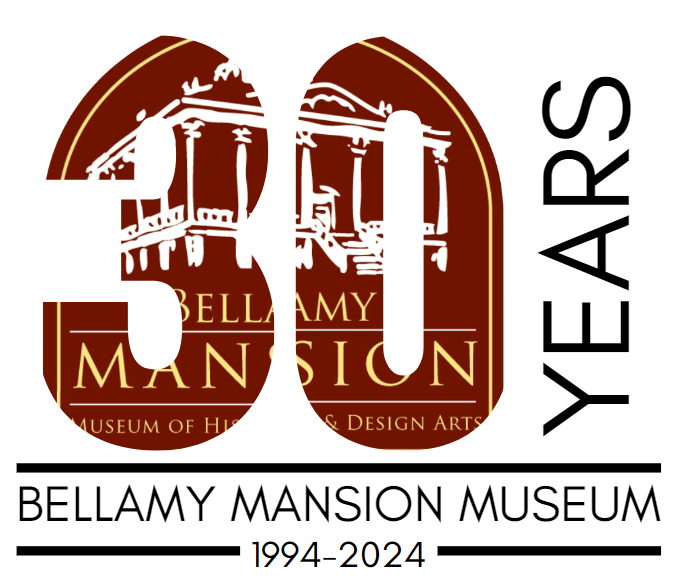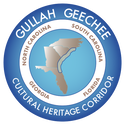 The unrestored mansion as it looked when Don spotted it during a trip to Wilmington. The unrestored mansion as it looked when Don spotted it during a trip to Wilmington. Don’s fascination with the Bellamy Mansion began in 1968, Sharpe observed, when he traveled to Wilmington for the Azalea Festival air show. As he rode past the mansion it captured his imagination. At that time there was a store, Divine Antiques, run by Virginia Jennewein, in the basement. The rest of the home was unoccupied. He stopped to look in but was refused permission to see the rest of the interior. In response, he made the rash statement that he would etch and donate the glass for the front door should it be restored. The woman in the antique store replied, “Anybody that damned crazy can go in.” A few years after that, Sharpe remembers visiting Floyd Hardware and found Don in a state of alarm. "He was grieving that the Bellamy mansion in Wilmington had been the victim of arsonists. The fire in the mansion which occurred during the early ‘70s came at a time of racial troubles, and Don deeply feels the irony of this because the house is an example of the genius of Black artistic craftsmanship, one of the finest Greek revival buildings in the entire South.”
More recently, Don took on the task of reproducing skeleton keys for the four adult bedroom level closets. The term ‘skeleton key’ refers to any key that can open multiple locks. Incidentally, closets were present in Europe from the 1500s but were usually whole rooms. America refined the idea into reach-in closets within walls in the mid 1800s. Early clothes closets employed pegs, although Thomas Jefferson reputedly had a hanger device in Monticello. One fine story of invention is that in 1903, Albert J. Parkhouse of the Timberlake Wire and Novelty Company in Jackson Mississippi, couldn't find a spot to hang his coat and upgraded the clothes peg idea by twisting wire into the shape we recognize as the modern hanger. Whatever the truth of these details, the Bellamy's locking closets, like the gasoliers and fixtures Don also fixed, were part of the ever-evolving world of domestic living.
The original mirror frames were finished with gold leaf. During the 1970s and 80s, while restoring the frames in his home workshop, the gilt would catch Don's eye and take his thoughts back to those original glory days of the house. He added that thinking of that Civil War era also called to mind the quote from Winston Churchill that, “History is written by the victors.” While considering the thousands of lives that were lost on both sides, Don laments there are no victors in war. In his view, both Confederates and Yankees came away physically and mentally crippled. Taking on an historic preservation project, which takes much time and attention to detail, often leads to reflection on the lives of those who came before.  Another tricky project was the restoration of the molding above the gasoliers. The parlor gasoliers were lit with coal gas, a by-product of naval stores processing. The medallions above the gasoliers were decorative, but served a practical purpose in hiding soot from the coal gas. The original medallions above the front parlor gasolier were, Don notes, "shaken loose by a group of kids on a tour in the house jumping up and down on the floor of the room above.” They had to be cleaned up and, in some cases, recast in plaster. Don shared some memories about restoring these and the similarly involved crown molding in the foyer. Doing the work at home, it attracted the attention of some neighborhood kids who asked if they could help. He let them pour some of the molding material and before it dried, he invited the kids to put their names on the backs of the molds. That idea came from the discovery, during Preservation NC's 1990s restoration, of the 'WBG' initials on the back of an original piece of plaster in the house. The story of it's discovery and the man who inscribed it is a mainstay of museum tours today. WBG was William Benjamin Gould, an enslaved plasterer who worked on many antebellum homes in the Wilmington area, including Bellamy's, and made a daring escape downriver in 1862. Letting the kids etch their names was a nod to this fascinating history and Gould, the skilled enslaved craftsman who had originally created this beautiful plasterwork in 1860.
Check out some pictures of the mansion and slave quarters restoration. Our website features a before and after gallery here. There you can appreciate Don's decades of work, as well as that of many other preservation experts.
0 Comments
Leave a Reply. |
Older Blog Posts
To see all previous blog posts, please click here. Blogs written after summer 2020 will be found on this page. AuthorOur blogs are written by college interns, staff, and Bellamy volunteers. Archives
July 2024
Categories |
|
Ticket Sales
10:00 am - 4:00 pm daily
Monday-Friday 9:30 am- 5 pm |
Admission Prices (tax not reflected)
Self-guided
|







 RSS Feed
RSS Feed




